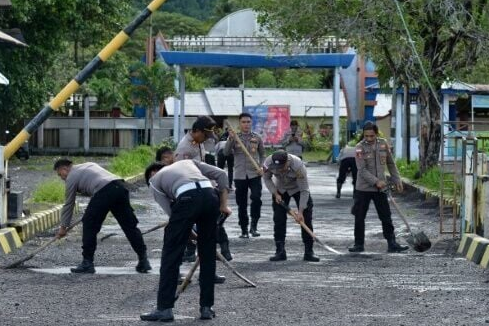MANADO, Indonesia – A remote Indonesian volcano sent a tower of ash spewing into the sky Friday, after nearly half a dozen eruptions earlier this week forced thousands to evacuate when molten rocks rained down on their villages.
Mount Ruang in Indonesia’s outermost region of North Sulawesi started erupting late Tuesday, stirring a spectacular mix of fiery orange lava, a towering ash column and volcanic lightning.
Officials on Friday morning said Ruang had calmed, but it started to belch ash again hours later after authorities maintained the highest alert level and told residents to stay out of a six-kilometre (four-mile) exclusion zone.
“I was very surprised, the mountain erupted again. We are scared,” said Riko, a 30-year-old resident of neighbouring Tagulandang island.
The country’s volcanology agency said the eruption sent a plume of smoke 400 metres (1,312 feet) above the peak.
“There was an eruption of Mt Ruang, North Sulawesi” at 1706 local time, 0906 GMT, it said in a statement according to AFP.
“The ash column was observed to be grey in colour… leaning towards the south.”
Hundreds of locals on neighbouring Tagulandang island were earlier seen cleaning up volcanic material from the harbour and their yards on Friday morning with the help of soldiers and police officers, according to an AFP journalist.
Some described their panic and rush to safety when the eruptions began days ago.
“I evacuated. There was a house. I stayed there. And then it rained and rocks fell. I prayed ‘God have mercy, please help me God’,” Ninice Hoata, a 59-year-old teacher, told AFP on Tagulandang.
Other residents pleaded for more assistance and expressed fears of another eruption before it struck.
“We really need tarpaulin assistance as soon as possible, to temporarily cover the leaking roof,” said 64-year-old Herman Sahoa.
“We are worried there will be a follow-up because there is information about that.”
Indonesia’s volcanology agency had earlier warned in a statement that the volcanic activity at Ruang was “still high” with potential dangers including flying rocks, hot clouds and lava flows.
Houses elsewhere could be seen lying empty and electricity was out in parts of the island before Friday’s eruption, the journalist said.
Officials said Thursday communications had already been knocked out on parts of both Ruang and Tagulandang, which is home to around 20,000 people.
Sahid Samihing, a 53-year-old Tagulandang resident, said he feared his belongings would be ruined after volcanic rocks peppered his roof.
“If it’s not covered, it will destroy the house,” the father-of-three said.
“It was terrifying. No one would not be scared. Everybody was scared. I experienced this event directly.”
More than 6,000 residents of Tagulandang had been evacuated to the other side of the island that faces away from the crater, Joikson Sagunde, an official from the Sitaro islands disaster management agency, told AFP.
There were no reports of deaths or injuries but authorities said a day earlier they hoped to evacuate 11,000 people from the exclusion zone.
The closure of a nearby international airport in Manado city, more than 100 kilometres (62 miles) from the crater, was also extended to Friday evening, national disaster mitigation agency (BNPB) spokesman Abdul Muhari said in a statement.






Discussion about this post